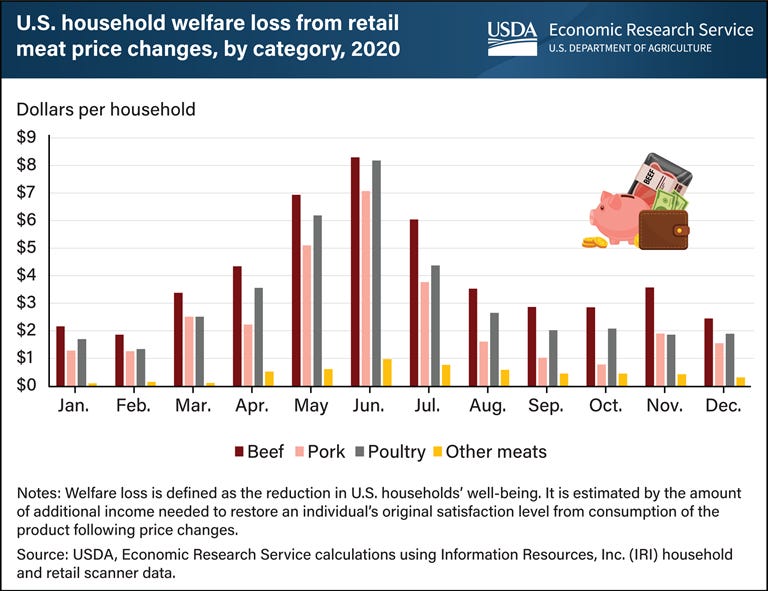🏛️Will public policy help catalyze regenerative grazing?
Perhaps the biggest unknown right now regarding regenerative agriculture, and in particular the regenerative animal protein space, is the role that the federal government will have in scaling the movement. Our piece last summer on “Carving up the Meatpacking Cartel,” portrayed a tenacious plan from the Biden administration to take on the big four meatpackers who have crushed nearly all small and mid-sized processors and increased their margins at the expense of both producers and consumers. As of today, the jury is still out on the government’s full-court press (or, frankly, lack of one so far). However, revisiting the administration’s approach to meatpacking and contextualizing it with other priorities related to regenerative agriculture serves as a useful exercise to understand what legislation and programs can have staying power beyond the next 3 years.
If these initiatives are only band-aid solutions and at the whims of a precarious political climate, they will simply not catalyze change across the regenerative meat value chain. The durability of the government’s involvement in causing said change also merits proper context: the current and continual rise in food prices, potential shortages, and crumbling processing infrastructure could potentially hinder or accelerate the government’s potentially outsized role in the regenerative transition. It’s crucial to understand if the USDA and Biden administration is pushing for more resilient, localized supply chains or working through major corporate food “partners” in the space.
Overall, given the over 6% rise in food prices expected for the rest of the year, it’ll take a significant amount of political courage to move the needle. This is especially relevant in the meat space: avian flu has wiped out over 10% of the nation’s hens and led to egg prices rising 25% month-over-month and feed and fuel pushing cattle prices to record highs. Rhetoric from the current administration is focused on blaming said prices on “greedflation” and corporate malfeasance, but the picture is quite complicated when it comes to the allocation of government funding. In particular, while the administration seems keen on pushing forward the Climate-Smart agenda through international institutions and corporate partners, it is working on the meat processing angle through trust-busting, legislation, and funding small and midsized players. It remains to be seen what will survive the 2023 Farm Bill and who will profit in the long run from the novel USDA initiatives and spent political will from the Biden administration.
Meat Processing
The three-fold approach to creating a more competitive and equitable meatpacking space is quite fascinating, though we have yet to see the impacts. The one that got the most aggressive headlines, and was the focus of my last piece, was the Federal Trade Commission’s public statements on enforcing the Packers and Stockyards Act of 1921. The FTC has only recently confirmed its fifth member which gives its Democratic majority a chance to push its agenda. The big four meatpacking CEOs recently trekked up to Washington and faced scrutiny, though we have not seen much on the FTC side in the past six months. Additionally, a recent report from the House’s Select Subcommittee on the Coronavirus Crisis alleges close collaboration between the major meatpackers and government officials during COVID to keep processing facilities open at the cost of workers’ welfare and under the veneer of keeping prices under control. This is a space to keep an eye on, especially to see how the FTC targets the buying power of major feedyards, yet I question the staying of such enforcement action if there is an administrative transition in 2024.
On the other hand, bi-partisan legislation appears to be more promising. The Cattle Price Discovery and Transparency Act (S.4030), sponsored by Sens. Chuck Grassley (R-Iowa) and Linda Fischer (R-Nebraska), is currently pushing for better price discovery points in the cattle market to boost competition for cattle prices and targeting the captive supply issue at the heart of the market. Though various corporate affiliated groups have released statements to the contrary, this bill appears to be a promising step forward. Senator Tester's (D-D.N.) Meat Packing Special Investigator Act, which is co-led by Republican Senators Grassley (R-Iowa) and Rounds (R-S.D.) would create the "Office of the Special Investigator for Competition Matters" within the U.S. Department of Agriculture and also presents promise. Various organizations and congresspersons have also pushed for country of origin labeling to return in stricter form, yet public action remains to be seen here.
Last, there are various funding opportunities still available regarding small and mid-sized meat processors totaling close to $1 billion dollars This includes. Meat and Poultry Processing Expansion Program (MPPEP), which will allocate $215M to existing processors, $1B worth of loan guarantees to expand processors and improve facilities, a new processing capacity technical assistance program, and potentially more. State-level programs are also doing this, as evidenced by Vermont, Ohio, and Wisconsin. Overall, as these funds pour in, they will make a significant dent in processing capacity, but more important than this is creating an environment with favorable unit economics. Additionally, there is little being done at the federal level to protect labor and make meat processing an attractive profession to young individuals. If we’re going to keep doing a “carrot”-based approach to government-backed meat processors, we need to ensure that a significant enough portion of the businesses the government is funding will be around in the coming years to make a tangible difference.
Climate-Smart Ag
The USDA’s parallel focus on Climate-Smart agriculture has garnered much fanfare and attention. With 450 applications to the Climate-Smart Commodities funding program (which pulls $1B from the Commodity Credit Corporation (CCC)) ranging from $5 million to $100 million on top of various international programs like the Agriculture Innovation Mission for Climate (AIM4Climate) that has secured over $4 billion in partner funding until 2025, climate-smart agriculture is shaping up to a key component of this administration’s agricultural push. In addition, market-based legislation like the bipartisan Growing Climate Solutions Act has temporarily stalled, though how climate-smart Ag is incorporated into the farm bill will be a balancing act.
However, what happens if the next administration has an alternative political gain for the CCC money? The CCC is at the discretion of the USDA and thus can be tailored to political ends. Though the $1B currently allocated to the climate-smart commodities program is a fraction of it, It appears likely that climate-smart initiatives will occur mainly through corporate partners This might lead to longer-lasting changes, albeit more tempered from an equity perspective, especially if Vilsack is right that consumers will care about more climate-smart goods. Keeping an eye on this grant’s winners will reveal how the USDA is thinking about a system-wide shift in agriculture, particularly if the administration’s approach to this sector via corporate and international partnerships might become more regional and smaller focused.
Conservation
The USDA’s Conservation Reserve Program (CRP) has been a policy mainstay since 1985, yet lackluster re-enrollment below 50% and only 800,000 new acres enrolled paints a new picture of how landowners are thinking about conservation, especially in the face of new ecosystem service markets and higher commodity prices. While programs like the CRP have staying power, I wonder how this “branch” of USDA programs will work compared to climate-smart Ag in the coming years. Many of the acres are available for emergency grazing and haying, but the paradigm of conservation is shifting and producers don’t necessarily want to be locked into a set of practices in a turbulent time.
Additionally, I’d be keen to see what the Bureau of Land Management mandates for its increasingly degrading lands, especially on 54 million acres that fail to meet its land health standards. Will the government mandate grazing management plans that align with regenerative grazing on such land? Will there be any enforcement measures taken against ranchers who operate below-said standards?
What to Watch for
Overall, the government appears to be threading the needle and trying to balance carrots and sticks for corporates and farmers regarding sustainable farming, meat processing, and land conservation. In particular, we are seeing more openness to punitive measures regarding meat processing, yet that will require political will beyond the next two years. On the climate-smart side, the government is entrenching its views into international collaborations and corporate partnerships, which have more staying power because it is in corporate interests potentially. This does come with a steep cost: I don’t necessarily see climate-smart as eye-to-eye with regenerative, especially when climate-smart agriculture is focused on reducing factory farming emissions instead of a holistic ecosystem, animal, and human health approach.
I hope the USDA can provide a fuller account of the root causes at the heart of our broken food system, as the different pathways appear to be disparate band-aids instead of an incision. The focus on the “invisible middle” of food processing is great, but I’d be keen on longer-term programming beyond immediate grants. Additionally, the elephant in the room remains monocrop subsidies to factory farming, yet this remains untouched. Now is the moment to re-tool our food system to focus on regenerative systems at both a regional and national level. I hope our politicians keep their eyes on the ball.
Disclaimer: The Regeneration Weekly receives no compensation or kickbacks for brand features - we are simply showcasing great new regenerative products.
If you have any products you would like to see featured, please respond to this newsletter or send an email to Kevin(at)soilworksnaturalcapital.com
The Regeneration is brought to you by Wholesome Meats | Soilworks | Grassroots Carbon| Grazing Lands






